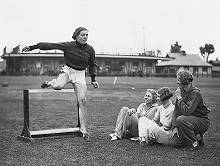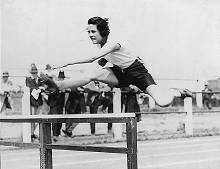Training
This section contains quotations from the women featured in
the book ‘A Proper Spectacle.’
At the turn of the century, many doctors believed that if
women took part in sport there was a strong chance they would become infertile, and it was
a common view that sporting women might even turn into men. It was a time when women could
not vote. Their main role in life was to marry and raise a family. Women who took part in
athletics were seen as particularly unfeminine.
 |
Swedish sprinter Maud
Sundberg competed in the Womens World Games of 1926 (held in Gothenburg) and the
Amsterdam Olympics of 1928:
" We had a lot of difficulties
introducing athletics for women in Sweden, people thought it would give us muscles like
men. Women should be ‘Standing in the kitchen and bearing children!’ was a
common saying."
Fellow World Games competitor for Britain, Vera Palmer
(1901-1998) said:
"I would think it would be safe to say
that 99% of the medical profession in this country were against women taking an active
part in athletics. They said you were leaving your womanhood on the track, and it was
quite possible none of us would ever have children. That made me laugh." |
In spite of all the pressure, many young
women continued to take part in sport - but it’s interesting to note that many of
them had male figures around them who encouraged their sporting aspirations.
| Violet Webb (Great Britain)
Hurdler, 1932 and 1936 Olympics "
My father spotted my talent and he made a complete flight of eight hurdles which we kept
at the ladies’ changing rooms at Paddington recreation ground. I jumped high over
them as it hurt when you hit the solid barriers! I broke my arm once doing the hurdles,
those awful hurdles. It didn’t deter me, I went straight back again. "
Audrey Brown (Great Britain) Sprinter
1936 Olympics
"My parents never saw any difference between my taking up athletics and my
brothers doing so, but my other middle class relatives and family friends were not so
accepting." |
 |
Eva Dawes (Canada) High Jumper 1932
Olympics
"Where we lived we had a ravine at the back of the house
and my father dug up a space and got some stands and cross bar and started training me out
there. To make me get over the bar he used to put 25 cents on the bar and said, ‘You
get over that, you can have this.’ "
Fernanda Bullano (Italy) Sprinter 1936
Olympics
"My father was an athlete and when I was in the Venesi
Unica Club, a female athletics group was just being set up. My father suggested I enrol
and so - without realising - I became an athlete. In 1930, no-one talked about women in
sport."
Swimming
Like athletics, swimming had been thought at first unladylike
and too physically demanding for women. Debates also arose about whether or not men and
women should swim together, and mixed bathing was banned at many pools
Jean McDowell (Great Britain) Freestyle Swimmer
1928
"In those days, there was no mixed
bathing, so the ladies of the Warrender Club (Edinburgh) had Saturday mornings, and of
course all the school kids were there. You’d just do what you could - there was no
idea that I, as an Olympic hopeful, must have room to swim! We just swam up and down -
there was no training like you people do today."
Women’s costumes became incredibly restrictive -
thick, sometimes woollen knickerbockers to the knee and tunics belted at the waist were
common place in 1900. These garments were vital to maintain decency and respectability -
but not helpful if you wanted to swim very fast. While swimming for men was one of the
first Olympic sports in 1896 women had to wait a few more years. The first competitive
swimming and diving came in 1912 at the Stockholm Games.
Joyce Cooper (Great Britain) Freestyle and
Backstroke Swimmer 1928 and 1932 Olympics
"My training started in the sea. We left Ceylon after the 1914-18 war, and
in 1925 I was staying in Eastbourne and I went down to my local pool where I saw Vera
Tanner swimming - she’d been in our Olympic team in 1924. She was doing the crawl
which was quite new then , and I thought ‘Oh! perhaps I’ll do that.’"
Sarah (Cissie) Stewart (Great Britain)
Freestyle Swimmer 1928 Olympics
"Things were different then. There were no sponsors,
no going to a warm country to train, no electronic timing, everything was timed by hand
held watches. I worked hard on my own to get where I did. My training was hard going - I
just swam up and down. I never had a coach, I just used to watch my older sister, Margaret
- she was a champion - and try to do the same, length after length. I was also working in
a baker’s shop and I had to wash the windows at half past six in the morning before
anyone else came in, and I got off at five o’clock."
Evelyn de Lacy (Australia) Freestyle swimmer 1936
"I was one of eleven children and learned to swim in the Swan River. Girls
weren’t allowed to swim in what was called ‘swim throughs’ before they were
fourteen as it was considered too hard for them. In Western Australia we did all our
swimming in the river. The pools were built on the river, with floating pontoons for
turning boards to cope with the fall of the tide."
Signe Johansson (Sweden) Diver 1924 Olympics
"Diving in the 1920s consisted of a standing jump from a diving board, five
and ten metres, standing and with advance. A dry dive construction was built in a room at
Stockholm Stadium existing of a springboard, lots of sawdust and a belt for the person who
was training. We often trained with our male friends who were all top gymnasts and taught
us a lot. There was not much practice in water." |

